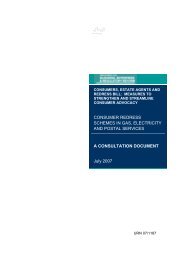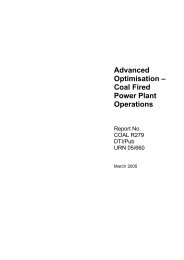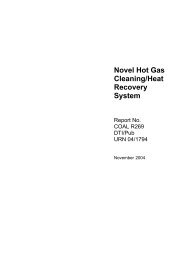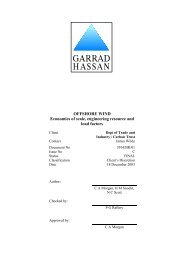(70) Therefore, the risk of sulphuric acid dew point attack ... - DTI Home
(70) Therefore, the risk of sulphuric acid dew point attack ... - DTI Home
(70) Therefore, the risk of sulphuric acid dew point attack ... - DTI Home
You also want an ePaper? Increase the reach of your titles
YUMPU automatically turns print PDFs into web optimized ePapers that Google loves.
application for which OTSGs may be particularly suitable. The OTSG can be<br />
designed to run dry at full exhaust temperature, removing <strong>the</strong> need for a<br />
bypass stack and providing a more simple and robust system.<br />
4.3.4 Gas Turbine Inlet Air Chilling<br />
Air intake cooling technology is used to enhance combined cycle power<br />
output and is particularly relevant for utility plant situated in warm climates<br />
where <strong>the</strong> air is dry and hot. The cooling <strong>of</strong> <strong>the</strong> air at <strong>the</strong> inlet results in a<br />
noticeable increase in mass flow through <strong>the</strong> gas turbine. This in turn results in<br />
a higher gas turbine power output as well as a slight increase in <strong>the</strong> steam<br />
production in <strong>the</strong> downstream HRSG.<br />
The cooling <strong>of</strong> <strong>the</strong> inlet air is achieved by means <strong>of</strong> a refrigeration system<br />
similar to <strong>the</strong> type employed in large building air conditioning units. The heat<br />
exchanger used to cool <strong>the</strong> incoming gas turbine air is formed from a coil <strong>of</strong><br />
finned tubes located in <strong>the</strong> inlet housing <strong>of</strong> <strong>the</strong> gas turbine. Cooled water is<br />
circulated through <strong>the</strong> tubes. The prior cooling <strong>of</strong> <strong>the</strong> water is achieved by<br />
chillers which are mass produced pieces <strong>of</strong> equipment and essentially fall into<br />
two categories:-<br />
• Centrifugal chillers<br />
• Absorption chillers<br />
In general, <strong>the</strong> absorption chiller delivers a lower gross plant power output<br />
than <strong>the</strong> centrifugal chiller due to <strong>the</strong> use <strong>of</strong> steam bleed from <strong>the</strong> HRSG to<br />
drive it. However in terms <strong>of</strong> plant net power outputs <strong>the</strong> two systems are<br />
approximately <strong>the</strong> same. This is because <strong>the</strong> centrifugal chiller requires an<br />
electric pump for circulation and <strong>the</strong>refore consumes a far greater amount <strong>of</strong><br />
auxiliary power as opposed to <strong>the</strong> steam driven circulation for <strong>the</strong> absorption<br />
method. Fur<strong>the</strong>r differences between <strong>the</strong>se two systems are described in<br />
greater detail by Elmasri [62] .<br />
Chilling <strong>the</strong> inlet <strong>of</strong> a large combined cycle allows extra power to be obtained<br />
from a plant (~ 5% increase in <strong>the</strong> net kWe output). The cost <strong>of</strong> that additional<br />
power output is <strong>the</strong> additional expense <strong>of</strong> <strong>the</strong> capital and operational costs <strong>of</strong><br />
<strong>the</strong> upstream chilling unit and o<strong>the</strong>r necessary modifications to <strong>the</strong> gas turbine<br />
itself. These have been estimated by Elmasri [62] at ~$250 per kWe <strong>of</strong> capacity<br />
gained above <strong>the</strong> initial hot design condition.<br />
The small-scale OTSG design may also find application in power<br />
augmentation for existing open cycle GT plant by GT air inlet chilling, as<br />
described above. A small OTSG unit can be added to an open cycle GT to<br />
provide steam for an absorption chiller. Again <strong>the</strong> advantage <strong>of</strong> <strong>the</strong> OTSG<br />
design is that protection in <strong>the</strong> event <strong>of</strong> a boiler trip is not required as <strong>the</strong><br />
OTSG may be designed to run dry at full exhaust temperature.<br />
4.3.5 Increases in Gas Turbine Exhaust Temperature<br />
The pursuit <strong>of</strong> higher efficiency CCGT plant has driven <strong>the</strong> rapid increases in<br />
GT exhaust temperature and mass flow rate imposed on HRSGs. The exhaust<br />
(86)
















